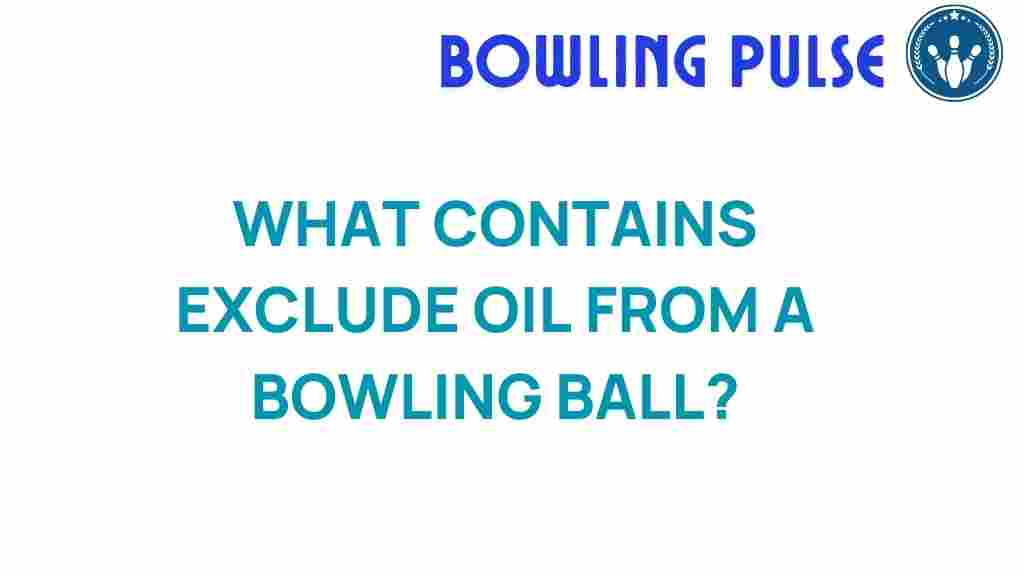Unveiling the Secrets: What Ingredients Exclude Oil from Bowling Balls?
Bowling is not just a recreational activity; it’s a sport that blends skill, science, and precision. One of the critical aspects of maximizing your performance in bowling is understanding your equipment, particularly your bowling balls. A central challenge bowlers face is oil on the lanes, which can significantly affect the performance of the bowling balls. In this article, we will explore the materials used in bowling balls, how oil exclusion works, and tips for maintaining your bowling equipment to enhance your gameplay.
The Science Behind Bowling Balls and Oil
Bowling balls are crafted from a variety of materials, each designed to provide different levels of grip and reaction depending on lane conditions. The bowling lane is usually treated with oil to protect the wood and create a specific playing environment. However, oil can also hinder the ball’s performance, especially if it is not properly managed. Understanding how to exclude oil from your bowling balls is crucial for any serious bowler.
Key Ingredients That Help Exclude Oil
Modern bowling balls are made from various materials, each with unique properties that aid in oil exclusion:
- Reactive Resin: This material absorbs oil, giving bowlers increased hook potential but requires regular maintenance.
- Urethane: Offers a balance between durability and performance, and is less susceptible to oil absorption than reactive resin.
- Plastic: Typically used for spare balls, plastic covers are the least affected by oil.
These materials are engineered to provide a specific reaction on the lanes, and understanding their properties can help bowlers choose the right ball for their playing style.
Understanding Oil Patterns
Oil patterns on the lanes play a significant role in how a bowling ball performs. Different patterns can create various challenges for bowlers, affecting how the ball hooks and rolls. Here are some common oil patterns:
- House Patterns: These are designed to make the game easier for beginners, typically featuring more oil in the middle of the lane.
- Sport Patterns: These patterns are more challenging, with less oil in the middle and more on the outside, requiring higher skill levels.
- Modified Patterns: A mix of both house and sport patterns, these are often used in tournaments.
Understanding these patterns can help bowlers adjust their techniques and select the right bowling equipment for optimal performance.
Step-by-Step Process for Oil Exclusion in Bowling Balls
To maintain your bowling balls and ensure they perform at their best, follow these steps:
- Clean Your Balls Regularly: Use a bowling ball cleaner to wipe down the surface after each use. This helps remove oil and dirt.
- Use a Ball Spinner: If possible, use a ball spinner to deep clean your bowling balls. This will help remove oil that has penetrated the surface.
- Rejuvenate the Surface: Periodically, consider using a surface rejuvenator to restore the ball’s grip and reaction.
- Store Properly: Keep your bowling balls in a temperature-controlled environment to prevent the materials from breaking down.
Bowling Techniques to Enhance Performance
Proper bowling techniques can also help mitigate the effects of oil on your bowling ball:
- Adjust Your Release: Different release techniques can help compensate for varying oil patterns.
- Change Your Target: Adjusting where you aim on the lane can help you adapt to different oil conditions.
- Experiment with Ball Speed: Altering your speed can change the ball’s reaction on the lane.
By mastering these techniques, you can maximize the effectiveness of your bowling equipment and improve your overall performance.
Troubleshooting Common Issues
Even with proper maintenance and technique, bowlers may encounter issues. Here are some common problems and their solutions:
- Ball Not Hooking: This may be due to too much oil on the ball. Clean it thoroughly and consider using a ball with a stronger coverstock.
- Inconsistent Performance: Check the surface of your ball for wear and tear. Regularly rejuvenate the surface to maintain consistency.
- Over-Absorption of Oil: If your ball absorbs too much oil, switch to a different material or type of ball that is less affected by oil.
If you continue to face issues, consult with a bowling pro or visit a bowling shop for expert advice.
The Role of Sports Science in Bowling Performance
Sports science plays a significant role in enhancing bowling performance. By applying principles of physics and biomechanics, bowlers can improve their techniques and equipment choices. Here are some areas where sports science impacts bowling:
- Ball Dynamics: Understanding how different materials react to oil and lane conditions can help in selecting the right bowling ball.
- Biomechanics: Analyzing a bowler’s stance and release can lead to improved accuracy and power.
- Technology in Equipment: Advances in bowling ball technology, including weight distribution and coverstock composition, are often rooted in scientific research.
Incorporating sports science into practice can lead to significant improvements in bowling performance.
Conclusion
Understanding how to exclude oil from bowling balls is essential for any bowler looking to enhance their game. By choosing the right materials, maintaining your equipment, and applying effective bowling techniques, you can significantly improve your performance on the lanes. Remember to stay informed about the latest advancements in bowling technology and maintain your equipment effectively. For more information on bowling techniques and equipment, check out this resource. Additionally, if you’re looking to purchase new bowling balls or accessories, visit this site for great options.
By mastering the art of oil exclusion and understanding your bowling balls, you will be well on your way to achieving higher scores and enjoying this fantastic sport even more!
This article is in the category Equipment and created by BowlingPulse Team
